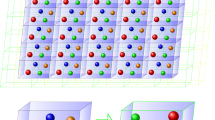Abstract
This paper is a continuation of a recent one in which, apparently for the first time, the existence of polaritons in ionic crystals was proven in a microscopic electrodynamic theory. This was obtained through an explicit computation of the dispersion curves. Here the main further contribution consists in studying electric susceptibility, from which the spectrum can be inferred. We show how susceptibility is obtained by the Green-Kubo methods of Hamiltonian statistical mechanics, and give for it a concrete expression in terms of time-correlation functions. As in the previous paper, here too we work in a completely classical framework, in which the electrodynamic forces acting on the charges are all taken into account, both the retarded forces and the radiation reaction ones. So, in order to apply the methods of statistical mechanics, the system has to be previously reduced to a Hamiltonian one. This is made possible in virtue of two global properties of classical electrodynamics, namely, the Wheeler-Feynman identity and the Ewald resummation properties, the proofs of which were already given for ordered system. The second contribution consists in formulating the theory in a completely general way, so that in principle it applies also to disordered systems such as glasses, or liquids or gases, provided the two general properties mentioned above continue to hold. A first step in this direction is made here by providing a completely general proof of the Wheeler-Feynman identity, which is shown to be the counterpart of a general causality property of classical electrodynamics. Finally it is shown how a line spectrum can appear at all in classical systems, as a counterpart of suitable stability properties of the motions, with a broadening due to a coexistence of chaoticity. The relevance of some recent results of the theory of dynamical systems in this connection is also pointed out.
Similar content being viewed by others
References
A. Lerose, A. Sanzeni, A. Carati, L. Galgani, Eur. Phys. J. D 68, 35 (2014)
G. Grosso, G. Pastori Parravicini, Solid State Physics (Academic Press, San Diego, London, 2014)
M. Born, K. Huang, Dynamical Theory of Crystal Lattices (Oxford U.P., Oxford, 1951)
J.A. Wheeler, R.P. Feynman, Rev. Mod. Phys. 17, 157 (1945)
P.P. Ewald, Ann. Phys. 49, 1 (1916)
W. Oseen, Ann. Phys. 48, 1 (1915)
M. Born, E. Wolf, Principles of Optics (Pergamon Press, Oxford, 1959)
A. Carati, L. Galgani, Nuovo Cimento B 118, 839 (2003)
M. Marino, A. Carati, L. Galgani, Ann. Phys. 322, 799 (2007)
M.D. Green, J. Chem. Phys. 22, 398 (1954)
R. Kubo, J. Phys. Soc. Jpn 12, 570 (1957)
J.H. Van Vleck, D.L. Huber, Rev. Mod. Phys. 49, 939 (1977)
A. Carati, J. Stat. Phys. 128, 1057 (2007)
A. Carati, A. Maiocchi, Commun. Math. Phys. 314, 129 (2012)
A. Maiocchi, D. Bambusi, A. Carati, J. Stat. Phys. 155, 300 (2014)
A. Carati, L. Galgani, A. Giogilli, S. Paleari, Phys. Rev. E 76, 022104 (2007)
A. Carati, F. Benfenati, A. Maiocchi, M. Zuin, L. Galgani, Chaos 24, 013118 (2014)
P. Drude, The Theory of Optics (Dover, New York, 1950)
P. Drude, Lehrbuch der Optik (Leipzig, 1900)
H.A. Lorentz, The Theory of Electrons (Dover, New York, 1952)
H.A. Lorentz, The Theory of Electrons, 1st edn. (Dover, New York, 1906)
M. Born, Optik (Springer, Berlin, 1933)
J.H. Van Vleck, The Theory of Electric and Magnetic Susceptibilities (Oxford U.P., Oxford, 1932)
S.R. de Groot, The Maxwell Equations (North-Holland, Amsterdam, 1969)
S.R. de Groot, L.G, Suttorp, Foundations of Electrodynamics (North-Holland, Amsterdam, 1972)
J.G. Kirkwood, J. Chem. Phys. 4, 592 (1936)
H.B. Callen, T.A. Welton, Phys. Rev. 83, 34 (1953)
C.W. Oseen, Phys. Z. 17, 341 (1916)
G.Jaffè, Dispersion und Absorption, in Handbuch der Experimentalphysik (Akademische Verlaggesellshaft, Leipzig, 1928)
R.L. Kronig, J. Opt. Soc. Am. 12, 57 (1926)
J.H. Van Vleck, Phys. Rev. 24, 330 (1924)
P.A.M. Dirac, Proc. Roy. Soc. A 167, 148 (1938)
A.I. Khinchin, Mathematical Foundations of Statistical Mechanics (Dover, New York, 1949)
V.V. Nemytskii, V.V. Stepanov, Qualitative Theory of Differential Equations (Dover, New York, 1989)
A.S. Besicovitch, Almost Periodic Functions (Dover, New York, 1954)
N. Bohr, H.A. Kramers, J.C. Slater, Phil. Mag. 47, 785 (1924), reprinted in B.L. Van der Waerden, Sources of Quantum Mechanics (Dover, New York, 1967)
W. Pauli, Optics and the Theory of Electrons (Dover, New York, 1973)
E. Nelson, Quantum Fluctuations (Princeton U.P., Princeton, 1985)
Author information
Authors and Affiliations
Corresponding author
Rights and permissions
About this article
Cite this article
Carati, A., Galgani, L. Classical microscopic theory of dispersion, emission and absorption of light in dielectrics. Eur. Phys. J. D 68, 307 (2014). https://doi.org/10.1140/epjd/e2014-50549-8
Received:
Published:
DOI: https://doi.org/10.1140/epjd/e2014-50549-8




